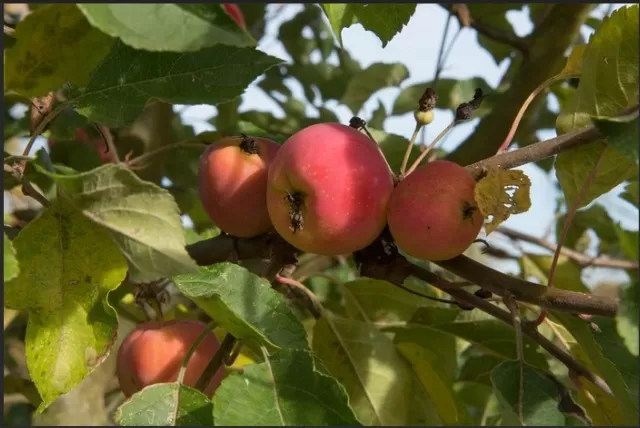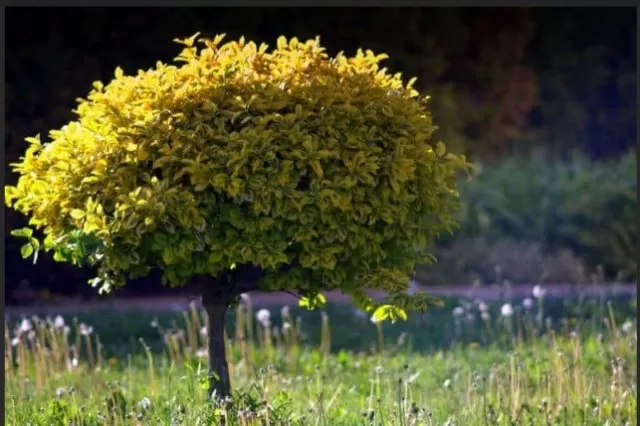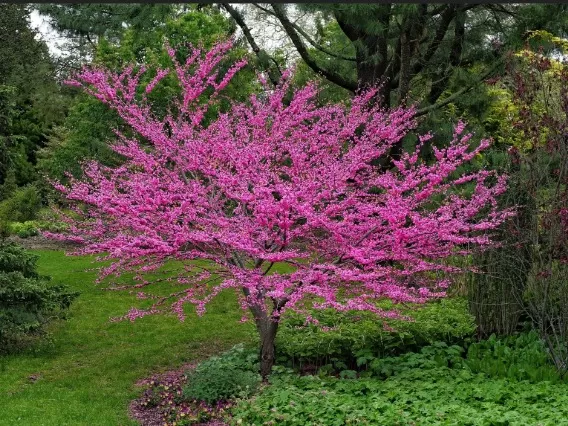Enhance Your Front Yard: Discover the 5 Best Dwarf Trees. Dwarf trees are a fantastic option for homeowners who want to add beauty and charm to their landscaping without the hassle of managing large trees. These compact trees not only provide aesthetic appeal but also require less maintenance and can fit well in smaller yards or as potted plants. Here are some beautiful and easy-to-care-for dwarf trees to consider for your next landscaping project
The Jelly King Crab Apple Tree (Malus “Jelly King”)

Some small trees serve primarily as decorative elements in landscaping, while others provide the additional benefit of yielding edible fruit.
The Jelly King crab apple tree, originating from New Zealand and reaching a maximum height of 13 feet, falls into the latter category. Its orange-pink fruits, aptly named for their suitability in jelly-making, make this tree a desirable addition.
During spring, the tree showcases beautiful, large white blossoms, adding to its appeal. Furthermore, the Jelly King crab apple tree is easy to maintain, requiring minimal pruning and thriving in either full sun or partial shade.
Japanese Maple (Acer japonicum)
The Acer japonicum, commonly known as the Japanese Maple, is highly favored for its vibrant foliage, making it a captivating focal point in landscaping throughout various seasons.
Step-by-Step Guide:
Enhancing Your Home with Japanese Maples
The Japanese Maple, scientifically known as Acer japonicum, is a popular choice for homeowners seeking vibrant foliage to create a captivating focal point in their landscaping. These trees offer a wide variety of types, each with its own unique characteristics. Heights of Japanese maples can range from 8 to 30 feet, providing options for different spaces.
- Assess your available space: Consider the size of your home and the available space in your yard. If you have limited space, opting for a dwarf variety is a wise choice. These compact trees typically reach a maximum height of around 10 feet, with a spread of 8 to 10 feet, making them perfect for smaller areas.
- Select the right variety: Choose a Japanese Maple variety that suits your preferences and the overall aesthetics of your landscape. There are numerous options available, each with their own leaf colors, shapes, and growth habits. Ensure the selected variety is suitable for the designated hardiness zones, typically zones 5 to 7, in your region.
Dwarf Chestnut Oak (Quercus prinoides)

The Quercus prinoides, also known as the Dwarf Chestnut Oak, is a distinctive oak tree species commonly found in eastern and central regions of North America.
While the average oak tree reaches heights of around 65 feet, chestnut oaks can grow between 59 and 72 feet tall. However, the Dwarf Chestnut Oak is characterized by its smaller stature, reaching a maximum height of approximately 20 feet.
These trees thrive in dry, rocky soil conditions. One notable feature of the Dwarf Chestnut Oak is its production of small acorns that have a sweet taste, making them a delightful treat for both humans and wildlife.
Hawthorn (Crataegus)
Hawthorn trees, belonging to the Crataegus genus, are known for their picturesque flowers during the spring season.
These trees also serve as a magnet for songbirds in fall and winter due to their enticing red berries.
However, it is important to note that Hawthorn trees are susceptible to diseases such as leaf blights and leaf spots, which can be a drawback.
To prevent infection, it is recommended to spray hawthorns with neem oil in the spring. Among the popular varieties of Hawthorn trees are the Crimson Cloud (C.
laevigata) and the Washington Hawthorn (C. phaenopyrum).
The latter variety is known for its increased resistance to diseases.
Redbud (Cercis canadensis)

The Cercis canadensis, commonly known as the Redbud tree, showcases stunning heart-shaped leaves and flowers that exhibit a range of captivating shades, varying by the specific variety.
During the spring season, these pink, white, or purple flowers bring a vibrant burst of color to any yard. With a maximum height of up to 10 feet, the redbud thrives in regions classified as zones 5 through 9.
Optimal growth conditions for redbuds include planting them in well-drained soil with a moderate moisture level, in areas that receive full sun to partial shade.
*The information is for reference only.